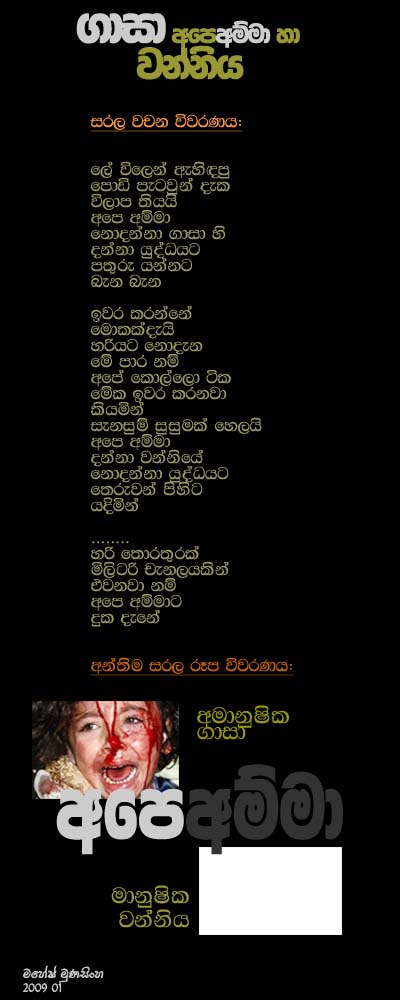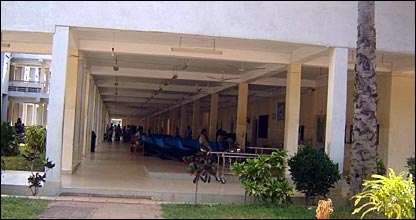UN Security Council Action Needed to Avert Humanitarian Catastrophe
April 9, 2009
(New York) – The Sri Lankan government should stop firing heavy artillery into the “no-fire zone” in the northern Vanni area where some 100,000 civilians are trapped by the separatist Liberation Tigers of Tamil Eelam, causing skyrocketing casualties, Human Rights Watch said today.
Human Rights Watch called upon the United Nations Security Council to take urgent measures, including by sending a special envoy to Sri Lanka, to bring an end to violations of international humanitarian law by government forces and the LTTE.
“Sri Lanka’s so-called ‘no-fire zone’ is now one of the most dangerous places in the world,” said Brad Adams, Asia director at Human Rights Watch. “The Security Council has quibbled over protocol when it should be acting to bring an end to this ghastly loss of life.”
People in the government-declared no-fire zone told Human Rights Watch that several areas have been subjected to heavy shelling since April 7, 2009, resulting in numerous civilian casualties. According to a doctor at the make-shift hospital in Putumattalan, on April 7 the hospital received 133 wounded civilians and 20 dead bodies. He said that all were the victims of a shelling in Pokkanai, a seaside area within the no-fire zone that is crowded with displaced persons.
Two other shelling attacks hit the same area on the morning of April 8. The doctor said the hospital received 296 wounded and 46 bodies on April 8, and 300 wounded and 62 bodies on April 9. Because of a lack of access to the conflict area, Human Rights Watch is unable to confirm these figures independently. On April 9 the International Committee of the Red Cross evacuated 230 injured civilians plus their relatives by ferry from Putumattalan.
A witness to the first attack on April 8 said that it took place at 7:30 a.m. near Pokkanai primary health center. Hundreds of civilians were waiting in line near a food distribution center when four or five artillery shells hit the area, killing at least 13 civilians immediately and wounding over 50 others. The doctor, who examined the site two hours after the attack, said that the shells were 120mm rounds and appeared to have been fired from Sri Lankan army positions to the south.
A 35-year-old man told Human Rights Watch that he was waiting in the food distribution line with his wife and 2-year-old child when the shelling started:
“There had been no distribution of milk powder for three months, and so when they announced that there would be distribution today [April 8], hundreds of people lined in queue. It was early in the morning. I heard the first shell, and hit the ground. Then several more landed nearby, after three or four minutes. I survived by miracle, but my 45-year-old uncle died on the spot – he lost both legs.
“I tried to get him to the hospital by bike – there are no cars, and no ambulances, and there were so many people – women, and children – injured in that attack. Now I am staying in the hospital with my wife and child, because we have nowhere else to go and the hospital may be the safest place. But there is also no place to stay here – there are so many injured people, and the new injured are being brought here all the time as we speak.”
Another attack followed several hours later. The doctor said the new patients continued to arrive by the minute.
Human Rights Watch called on the Sri Lankan government and the LTTE to urgently facilitate the safe evacuation of civilians from the conflict area. Approximately 100,000 civilians are believed to be trapped in the roughly 20-square-kilometer area under LTTE control.
Several people who recently managed to flee the no-fire zone reported that escape was becoming increasingly difficult because the LTTE had built an earth mound and posted sentries at regular intervals on the zone’s perimeter. One woman who escaped in mid-March said that LTTE fighters had opened fire on her group as they tried to flee in the dark, but they kept running. A large number spent the night hiding in the Nanthikadal lagoon, which borders the no-fire zone, standing in water up to their necks. Only when it was light enough for government forces to see that they were civilians did the group emerge from the water toward the government side.
A 19-year-old youth who tried to escape with his family on April 1 said that the LTTE had forced his parents to turn back. He and his younger brother made a run for it, however, and eventually made it to the government side.
The Sri Lankan government continues to prevent the media and other independent observers from traveling to the war-affected Vanni region to report on the situation. The doctor told Human Rights Watch that he and other medical staff who have been providing information from inside the no-fire zone have been threatened by the authorities and ordered not to speak to the media.
“We decided that we are beyond the point where we can just complain to the authorities,” the doctor said. “Because we told them a hundred times and they have failed to take any proper steps to stop the attack on civilians and did not send in the necessary amount of medications.
“We have been reporting every day, every day providing reports to relevant authorities and to the international community, and still there are no real steps taken to save these innocent civilians.”
Under international humanitarian law applicable to the armed conflict in Sri Lanka, both the government armed forces and the LTTE are obligated to take all feasible precautions to minimize harm to civilian life and property. Since January, both sides have shown little regard for the safety of civilians in the Vanni, and more than 3000 civilians are believed to have died in the fighting. The LTTE has violated the laws of war by using civilians as “human shields,” by preventing civilians from fleeing the combat zone and by deliberately deploying their forces close to densely populated civilian areas. The Sri Lankan armed forces have indiscriminately shelled densely populated areas, including hospitals, in violation of the laws of war.
Individuals who commit serious violations of international humanitarian law with criminal intent – that is, deliberately or recklessly – should be prosecuted for war crimes. War crimes include using human shields and deliberately attacking civilians. Evidence as to whether indiscriminate attacks on civilians were deliberate or reckless would include: information on the known number of civilians in the area under attack, attacks striking presumptively civilian objects such as hospitals, and a showing that such attacks occurred repeatedly. In addition to those who ordered or executed unlawful actions or attacks, commanders who knew or should have known of war crimes being committed and failed to take measures to stop them can be held responsible as a matter of command responsibility.
Sri Lanka has an obligation under international law to investigate credible allegations of war crimes, including by members of its own forces, and appropriately prosecuting those responsible.
“War crimes by the Tamil Tigers don’t give Sri Lankan commanders free rein to ignore civilian casualties,” said Adams. “Accountability is a two-way street.”
Source : HRW.ORG
Filed under: News, Petition & Statement | Tagged: HRW, Human Rights Watch, LTTE, Mahinda Rajapaksa, Mullaittivu, Sinhala extremists, SL Army, trapped, Wanni | Leave a comment »










